|
Comments on Lego (read the
article)
Lego illustrates very well the two product line firm, with different competitive positions in each segment, and different "rules of the game" and development perspectives
Lego is a leader in the market of traditional plastic construction toys for
pre-school and kindergarten children. This market is mature and doesn't have a
high growth. In the 1990's, under the impulsion of its COO (chief operating
officer), Mr Ploughmann, and with the approval of the owner and CEO (chief
executive officer), Mr Kristiansen, Lego tried to hop onto the new market of
modern animated interactive toys for children. But this strategic move ended in a very costly flop. The reasons are many : without having analysed them
(markets, competition, Lego's position, etc.), we can only point out that Lego had few
competitive advantages in this new market. The only identifiable "Key Success
Factor" was a well developed distribution
network, presumably adapted to the market. Even its image as a strong firm in the children toys industry did not
help, because the image of Lego is firmly attached to traditional toys, not to
new toys. The Japanese mfrs, like Nintendo, Sega, Sony and others, were much
better positioned in terms of image. Consider a manufacturer of bicycles : would
you automatically consider him a trustable manufacturer of motorcycles ? Another
example : would you automatically buy a microwave oven from a traditional
manufacturer of stoves ?
The KFS ("key success factors") in the plastic brick segment (which Lego mastered) were quite different from those in the new segment
It is likely that Lego lacked the know-how to develop, manufacture, and market these
news toys too. Only an in-depth investigation of the industry, the competitors
(Hasbro, Mattel, the Japanese toy mfrs, etc.), the customers, the channels of
distribution, the various costs structures, the production organisations and
processes, etc. would give a complete answer to the question : "Why did Lego fail ?"
Profit warning
In January 2004, the CEO, Mr Kristiansen, published an annoucement warning
that Lego would be unprofitable in 2003 (Note the "forecast" concerning 2003:
in January 2004, the final 2003 accounts were not prepared yet). But he also
predicted that Lego would be profitable again in 2004.
Hindsight view
Now, in 2005, we can retrospectively see what happened in 2004 : the sales
kept declining, the losses continued. Mr Kristiansen, who is the majority owner,
is no longer the CEO. The COO was fired. A new top management team arrived.
Probably, a vigourous cleaning up of operations and of accounts took place
(selling off of non strategic activities, write-off of many potential losses,
etc.) Lego is still a private firm, not listed on Yahoo Finance, but it
publishes an annual report (available in Danish !, the English version, for some
reason, today, cannot be accessed on the Net). A financial analysis would show the
evolutions in the balance sheet, the liabilities, and the financing.


This brief Lego case is quite interesting because it is simple, streamlined,
and absolutely classical : we are the leader in a mature market, new markets
next to ours are in fast development, what strategy to adopt to face the future
? Should we try and ride the new growth ? How ?
Cost models and unit
costs
When complete costs per unit are meaningful...
In a firm making only one type of product, the concept of complete cost
per unit (or complete unit cost) is meaningful : it is, naturally enough,
the total costs divided by the number of products manufactured. But in a firm
making several types of product, this is no longer the case. To ask what is the
complete cost of a car, or the complete cost of this wristwatch - presumably to
compare it to its price - is not meaningful. Let's see why, with an example even
simpler than the bicycle manufacturer.
Consider a furniture manufacturer which only makes chairs (all identical
chairs). Suppose the variable costs per chair are 50 € (raw materials, and
direct labor) ; the firm makes, say, 4000 chairs per year (it's a small
workshop) ; and there are some fixed costs : 100 000 €. Clearly, we can compute
a total cost per unit ; we get 75 €. In this example, to ask "how much does it
cost to make one chair ?" is meaningful.
... and when they are not. The vacuous concept of "fair value"
But, as soon as there are several different products manufactured in the same
factory, the concept of total cost per unit becomes artificial. Yet, this
doesn't mean that it is useless, because we need to set selling prices, and we
must compare them to something. But the idea that an object has an intrinsic
complete cost, which leads, in turn, to the concept of fair value, is an
old aristotelian idea, which Thomas Aquinas and Marx considered too, that is
devoid of content.
Making chairs and tables
Suppose, now, the manufacturer makes chairs, and also tables. The variable
cost of a table is 100 € ; and the firm makes 1000 tables per year. Now the
total costs of the firm are 400 000 euros. Then, there is no way to come up with
a unique cost per unit for each product. Of course, we can use "allocation
keys" to dispatch the fixed costs onto the two product lines, but it does
not correspond to any meaningful cost generation process per product line.
We need selling prices per product though
The heart of the problem becomes clear when we introduce selling prices.
Suppose the chairs sell for 60 € apiece, and the tables for 130 € apiece. The we
have the following income statement :

The origin of the problem: the factors driving sales and costs
The crux of the matter is that
total revenue of the firm = a function of the unit prices and the
volumes
but
total costs of the firm are not a function of complete unit costs and
volumes, because there is no concept of complete unit cost.
An appropriate cost model
What is true is the the total costs of the firm are a function of all the
costs accumulated in every area of the firm. Some of them are function of the
volume, some are not. We can only work with variable unit costs ; the rest is
artificial.
But we want to set a price list. We have a choice of solutions. The price
list : chairs 60, and tables 130 is not an acceptable one, because we lose
money.
For instance (70, 130) is OK, we make a profit of 10 000 €
(60, 160) is a limit case : we make a profit of zero.
Exercise:
- on a plane where the abscissa is the price of chairs and the ordinate is
the price of tables, draw the region of points where the firm is profitable.
- how does this region move when we change the volumes ?
Question: Is it acceptable to sell tables at 90 € and chairs at, say,
80 € ? (That way, we make a profit of 10 000 €. But we sell tables below
variable costs.)
Answer: There is no rule. In some industries, it is forbidden to sell
"below cost" (but it is not too hard to artificially lower costs, in the
accounts, to overcome this rule). In many industries, it is quite common to sell
some products below variable costs. Usually, the negative contribution is
treated as a marketing investment for the other product line. This is, for
instance, the case with Haute Couture : the Haute Couture dresses, even though
they are very expensive, are usually sold below their direct costs ; but the
Haute Couture line of a luxury garment manufacturer (Chanel, Dior, Cardin, etc.)
is usually complemented by a line of ready-to-wear garments (and, sometimes,
accessories) which is very profitable. The same is true in cars and other
industries. It is not necessarily the high end of the range that has a negative
contribution, sometimes it is, on the contrary, the low end (the so-called
"produits d'appel", products to attract customers into stores, and then try and
sell them more profitable products).
The chairs and tables example is very simple, but it illustrates exactly the problem
The calculations, as well as the model, are extremely simple and
straightforward. The idea is not to focus on the calculations (although we must
feel comfortable with them), but on the observation that, contrary to
traditional and popular belief, the concept of complete cost of an object is
devoid of meaning.
The questionable intelligence of some accounting textbook authors
Those textbooks in which you read "it is difficult to calculate the exact
complete cost of such and such product, but we can get close to it by using
reasonable allocation keys, etc.", you are allowed to take a dim view of.
The concept of value is subtle
Even the concept of value is a bit more subtle than it looks. When a firm
sells a product for, say, 100 €, to a client, it is recorded in its stocks at
another value, say, 70 €. So the product is worth 70 € euros to the firm. Is it
worth 100 € to the client ? Well, it should be worth more. This is precisely why
the client prefers the product to keeping 100 €. Conclusion : values are
different for different people.
Product differentiation:
Sometimes, manufacturers are lead to differentiate artificially their
products in order to serve different markets. An example is a manufacturer of
refrigerators who will manufacture 300liters refrigerators on the same assembly
line but then "create" top of the range products and bottom of the range
products by including or not various bells and whistles which do not cost much
but will entail large price differences. Then the bottom of the range will have
a low contribution per refrigerator and the top of the range will be much more
profitable.
There are cases where it is the low end of the range which is profitable and
the high end which is not.
When we need to produce all the products onto the same assembly line, with essentially the same costs per unit, in order to serve different markets, and we need to have a wide ranging product list (otherwise either we will sell too low, or we will have too small a market share), we run into the problem. The solution: artificial product differentiation. In the middle ages, assembly lines did not exist, only small workshops manufacturing pieces one by one with essentially only variable costs, therefore the problem was not clear to the thinkers of the time. Furthermore, putting God everywhere to explain the world was the common approach, therefore it seemed natural to think that things had a "fair value", presumably fixed by the deity.
Yield management:
The extreme example of artificial (but unavoidable, in good management)
product differentiation is the "yield management" invented by American Airlines
in the 60's in order to fill its planes and get the most revenue per plane.
It starts from the observation that if we price all the seats to go, say,
from Paris to New York at the same price, the price will be too expensive for
some, and too cheap for others.
So the airline introduces artificial constraints on cheap tickets like "non
refundability", "obligation to stay one week end in New York", etc. That way,
wealthy businessmen will not purchase these tickets, but more expensive ones
with no constraints.
And that way, the airline fills its plane with people paying the most they
can. I.e. the airline "manages the yield" of the plane.
This technique is also applied by railway companies, tourism firms, and
generally speaking many firms selling highly perishable products or services.
Product differentiation can be viewed as a form of yield management.
Go to lesson 6
|


